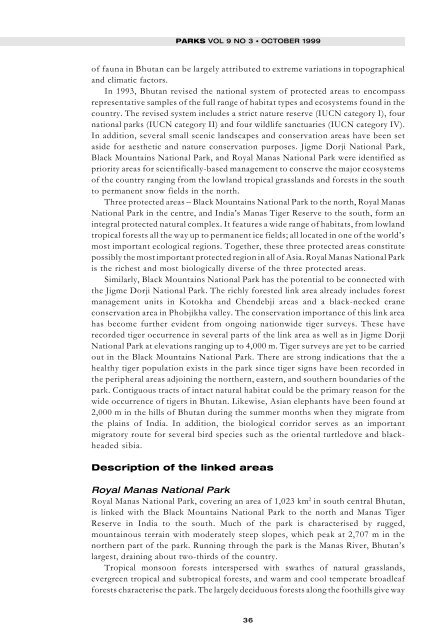Parks - IUCN
Parks - IUCN
Parks - IUCN
Create successful ePaper yourself
Turn your PDF publications into a flip-book with our unique Google optimized e-Paper software.
PARKS VOL 9 NO 3 • OCTOBER 1999<br />
of fauna in Bhutan can be largely attributed to extreme variations in topographical<br />
and climatic factors.<br />
In 1993, Bhutan revised the national system of protected areas to encompass<br />
representative samples of the full range of habitat types and ecosystems found in the<br />
country. The revised system includes a strict nature reserve (<strong>IUCN</strong> category I), four<br />
national parks (<strong>IUCN</strong> category II) and four wildlife sanctuaries (<strong>IUCN</strong> category IV).<br />
In addition, several small scenic landscapes and conservation areas have been set<br />
aside for aesthetic and nature conservation purposes. Jigme Dorji National Park,<br />
Black Mountains National Park, and Royal Manas National Park were identified as<br />
priority areas for scientifically-based management to conserve the major ecosystems<br />
of the country ranging from the lowland tropical grasslands and forests in the south<br />
to permanent snow fields in the north.<br />
Three protected areas – Black Mountains National Park to the north, Royal Manas<br />
National Park in the centre, and India’s Manas Tiger Reserve to the south, form an<br />
integral protected natural complex. It features a wide range of habitats, from lowland<br />
tropical forests all the way up to permanent ice fields; all located in one of the world’s<br />
most important ecological regions. Together, these three protected areas constitute<br />
possibly the most important protected region in all of Asia. Royal Manas National Park<br />
is the richest and most biologically diverse of the three protected areas.<br />
Similarly, Black Mountains National Park has the potential to be connected with<br />
the Jigme Dorji National Park. The richly forested link area already includes forest<br />
management units in Kotokha and Chendebji areas and a black-necked crane<br />
conservation area in Phobjikha valley. The conservation importance of this link area<br />
has become further evident from ongoing nationwide tiger surveys. These have<br />
recorded tiger occurrence in several parts of the link area as well as in Jigme Dorji<br />
National Park at elevations ranging up to 4,000 m. Tiger surveys are yet to be carried<br />
out in the Black Mountains National Park. There are strong indications that the a<br />
healthy tiger population exists in the park since tiger signs have been recorded in<br />
the peripheral areas adjoining the northern, eastern, and southern boundaries of the<br />
park. Contiguous tracts of intact natural habitat could be the primary reason for the<br />
wide occurrence of tigers in Bhutan. Likewise, Asian elephants have been found at<br />
2,000 m in the hills of Bhutan during the summer months when they migrate from<br />
the plains of India. In addition, the biological corridor serves as an important<br />
migratory route for several bird species such as the oriental turtledove and blackheaded<br />
sibia.<br />
Description of the linked areas<br />
Royal Manas National Park<br />
Royal Manas National Park, covering an area of 1,023 km 2 in south central Bhutan,<br />
is linked with the Black Mountains National Park to the north and Manas Tiger<br />
Reserve in India to the south. Much of the park is characterised by rugged,<br />
mountainous terrain with moderately steep slopes, which peak at 2,707 m in the<br />
northern part of the park. Running through the park is the Manas River, Bhutan’s<br />
largest, draining about two-thirds of the country.<br />
Tropical monsoon forests interspersed with swathes of natural grasslands,<br />
evergreen tropical and subtropical forests, and warm and cool temperate broadleaf<br />
forests characterise the park. The largely deciduous forests along the foothills give way<br />
36

















